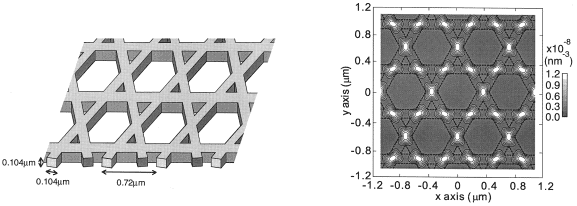Materials Science Laboratory
If we consider a quantum dot (QD) as a building block and put it on a site of lattice, we can create an artificial crystal called quantum dot superlattice. There are several advantages of using semiconductor dots in making artificial crystals. First, the lattice structure can be widely chosen. One can fabricate a lattice structure which does not exist in nature. Second, the electron filling can be freely modified. As a consequence, various types of interesting electronic properties can be expected. We have proposed that specific types of quantum dot superlattice exhibit ferromagnetism which should be observable in experiment [1].
Recently, we have presented the theoretical design of quantum dot superlattice exhibiting ferromagnetism by using a quantum-wire network shown in Fig. 1 [2]. The electronic structure calculations based on a local spin density approximation (LSDA) show that our designed QD artificial crystal from a structure comprising the crossing 0.104-μm-wide InAs quantum wires forms an effective Kagome lattice having a flat band. Our examined QD artificial crystal has the ferromagnetic ground state when the flat band is half-filled as shown in Fig. 2, even though it contains no magnetic elements. We have also demonstrated that the ferromagnetic and paramagnetic states can be freely switched by changing the electron filling.
By extending the idea of dot superlattices, one can think of other interesting possibilities of artificial materials. In the near future, the semiconductor nano-technology may allow us to realize other interesting electronic properties, such as superconductivity, in quantum dot superlattices.
[1] H. Tamura, K. Shiraishi, and H. Takayanagi, Jpn. J. Appl. Phys. 39 (2000) L241.
[2] K. Shiraishi, H. Tamura, and H. Takayanagi, Appl. Phys. Lett. 78 (2001) 3702.

|
|